AUDI A6 2012 Repair Manual
Manufacturer: AUDI, Model Year: 2012, Model line: A6, Model: AUDI A6 2012Pages: 298, PDF Size: 74.43 MB
Page 61 of 298
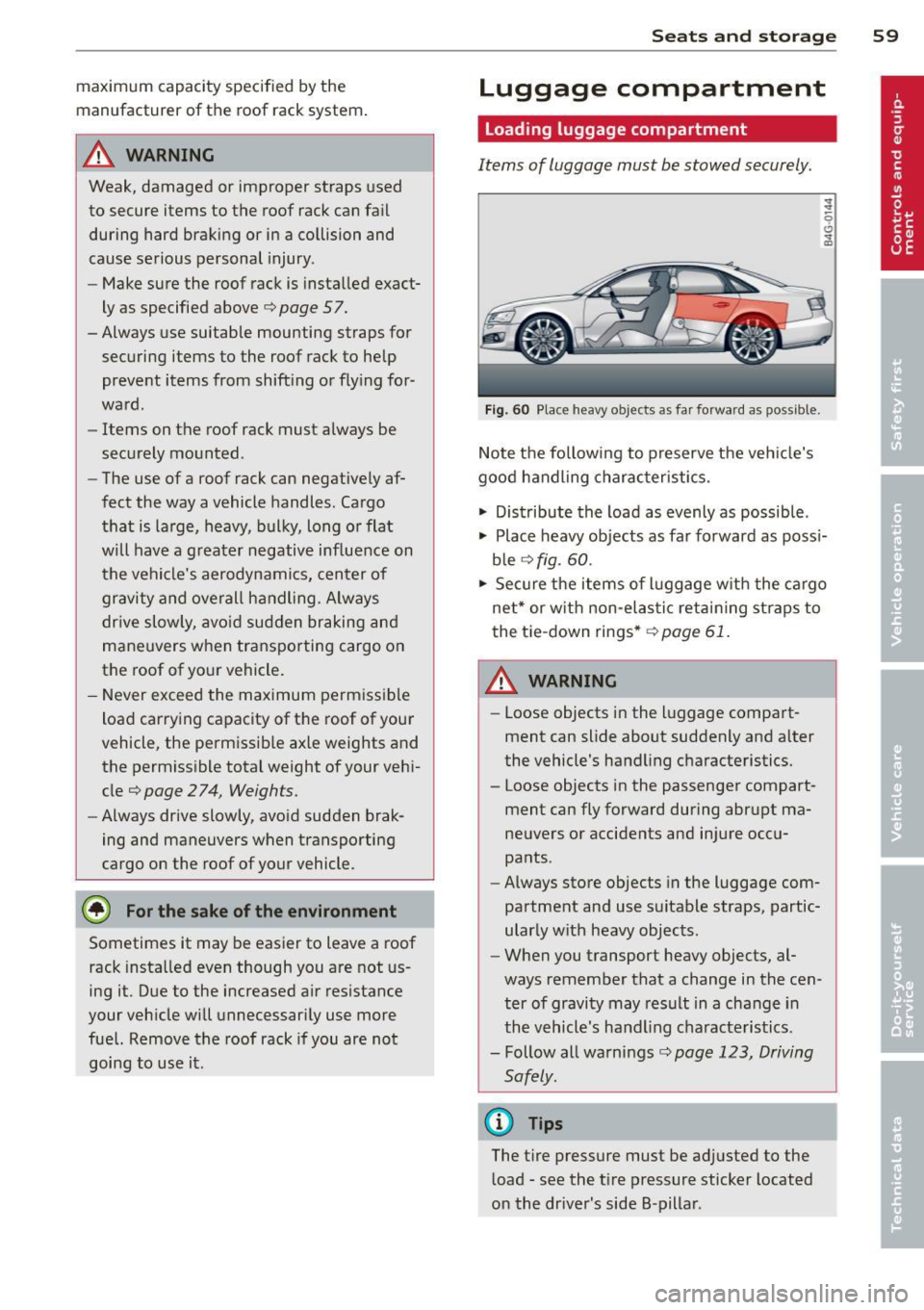
maximum capacity specified by the
manufacturer of the roof rack system.
A WARNING
Weak, damaged or improper straps used
to secure items to the roof rack can fail during hard braking or in a collision and
cause serious personal injury .
- Make sure the roof rack is installed exact
ly as specified above¢
page 57 .
- Always use suitable mounting straps for
securing items to the roof rack to help
prevent items from shifting or fly ing for
ward.
- Items on the roof rack must always be
securely mounted.
- The use of a roof rack can negatively af
fect the way a vehicle handles . Cargo
that is large, heavy, bulky, long or flat
will have a greater negative influence on
the vehicle's aerodynamics, center of
gravity and overall handling . Always
dr ive slowly, avoid sudden braking and
maneuvers when transpo rting cargo on
the roof of your vehicle.
- Never exceed the maximum permissible
load carrying capacity of the roof of your
vehicle , the permissib le axle weights and
the permissible total weight of your veh i
cle ¢
page 274, Weights.
-Always drive slowly, avoid sudden brak
ing and maneuvers when transporting
cargo on the roof of your vehicle .
@) For the sake of the environment
Sometimes it may be easier to leave a roof
rack insta lled even though you are not us
ing it . Due to the increased air resistance
your veh icle will unnecessar ily use more
fuel. Remove the roof rack if you are not
going to use it .
.
Sea ts a nd s to rage 59
Luggage compartment
Loading luggage compartment
Items of luggage must be stowed securely.
Fig. 60 Pla ce hea vy o bject s as far forward a s possible .
Note the following to preserve the vehicle's
good handling charac teristics.
.,.. Distribute the load as evenly as possible .
... Place heavy objects as far forward as poss i
ble ¢
fig. 60 .
... Secure the items of luggage w ith the cargo
net* or w ith non -elastic retaining straps to
the tie-down rings * ¢
page 61.
A WARNING
- Loose objects in the l uggage compart
ment can slide about suddenly and a lter
the vehicle's handling characteristics.
- Loose objects in the passenger compart
ment can fly forward during abr upt ma
neuvers or accidents and injure occu
pants .
- Always store objects in the luggage com
partment and use suitable straps, partic
ularly with heavy objects .
-
-When you transport heavy objects, al
ways remember that a change in the cen
ter of gravity may result in a change in
the vehicle's handling characteristics.
- Follow all warnings¢
page 123, Driving
Safely .
(D Tips
The tire pressure must be ad justed to the
load - see the t ire pressure sticker located
on the dr iver's side B -pillar .
Page 62 of 298
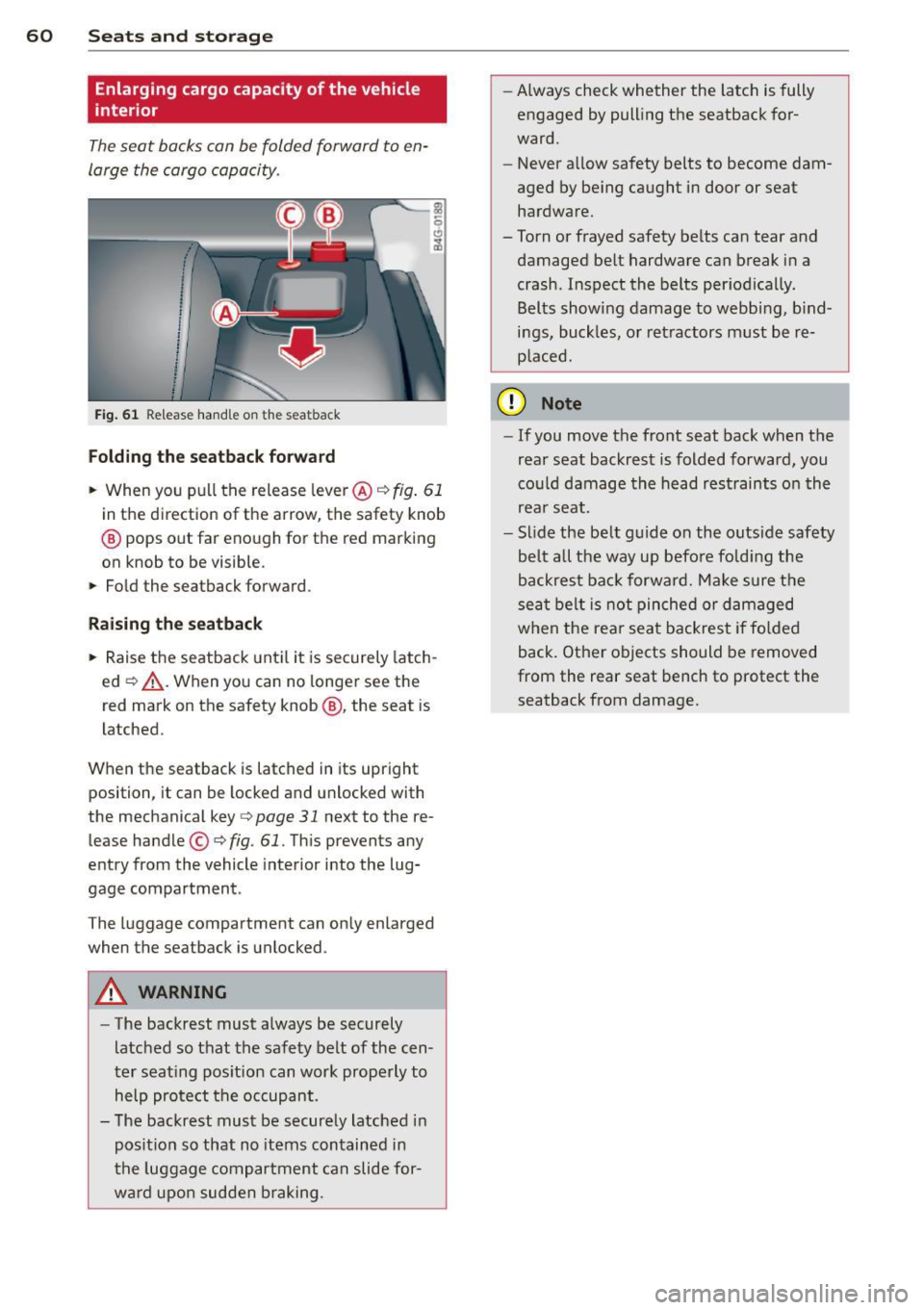
60 Seats and st o rage
Enlarging cargo capacity of the vehicle
interior
The seat backs can be folded forward to en
large the cargo capacity .
Fig. 61 Re lease handle on the seatback
Folding th e se atback forward
.. When you pu ll the release leve r@ ¢ fig. 61
in the direction of the arrow, the safety knob
@ pops out far enough for the red marking
on knob to be visible.
.. Fold the seatback forward .
Raising th e se atback
.. Raise the seatback until it is securely latch
ed ¢&_ . When you can no longer see the
red mark on the safety knob@, the seat is
l atched.
When the seatback is latched in its upright
position, it can be locked and unlocked with
the mechanical key
c> page 31 next to the re
lease handle ©
c>fig. 61. This prevents any
entry from the vehicle interior into the lug
gage compartment .
The luggage compartment can only enlarged
when the seatback is unlocked.
A WARNING
-
-The backrest must a lways be securely
latched so that the safety belt of the cen
ter seating pos ition can work properly to
help protect the occupant .
- The backrest must be securely latched in
posit ion so that no items contained in
the luggage compar tment can slide for
wa rd upo n sudden b raking . -
Always check whether the latch is fully
engaged by pull ing the seatback for
ward.
- Never allow safety belts to become dam
aged by be ing caught in door or seat
hardware.
-Torn or frayed safety belts can tear and
damaged be lt hardware can break in a
crash . Inspect the belts periodica lly.
Belts show ing damage to webb ing, b ind
ings, buckles, or retractors must be re
p laced.
(D Note
- If you move the front seat back when the
rear seat backrest is folded forward, you
cou ld damage the head r estraints on th e
rea r seat.
- Slide the belt guide on the outside safety
be lt a ll the way up befo re fold ing the
backrest back forward. Make sure the
sea t belt is not pinched or damaged
when the rear seat backrest if fo lded
back. Other objects should be removed
from the rear seat bench to protect the
seatback from damage.
Page 63 of 298
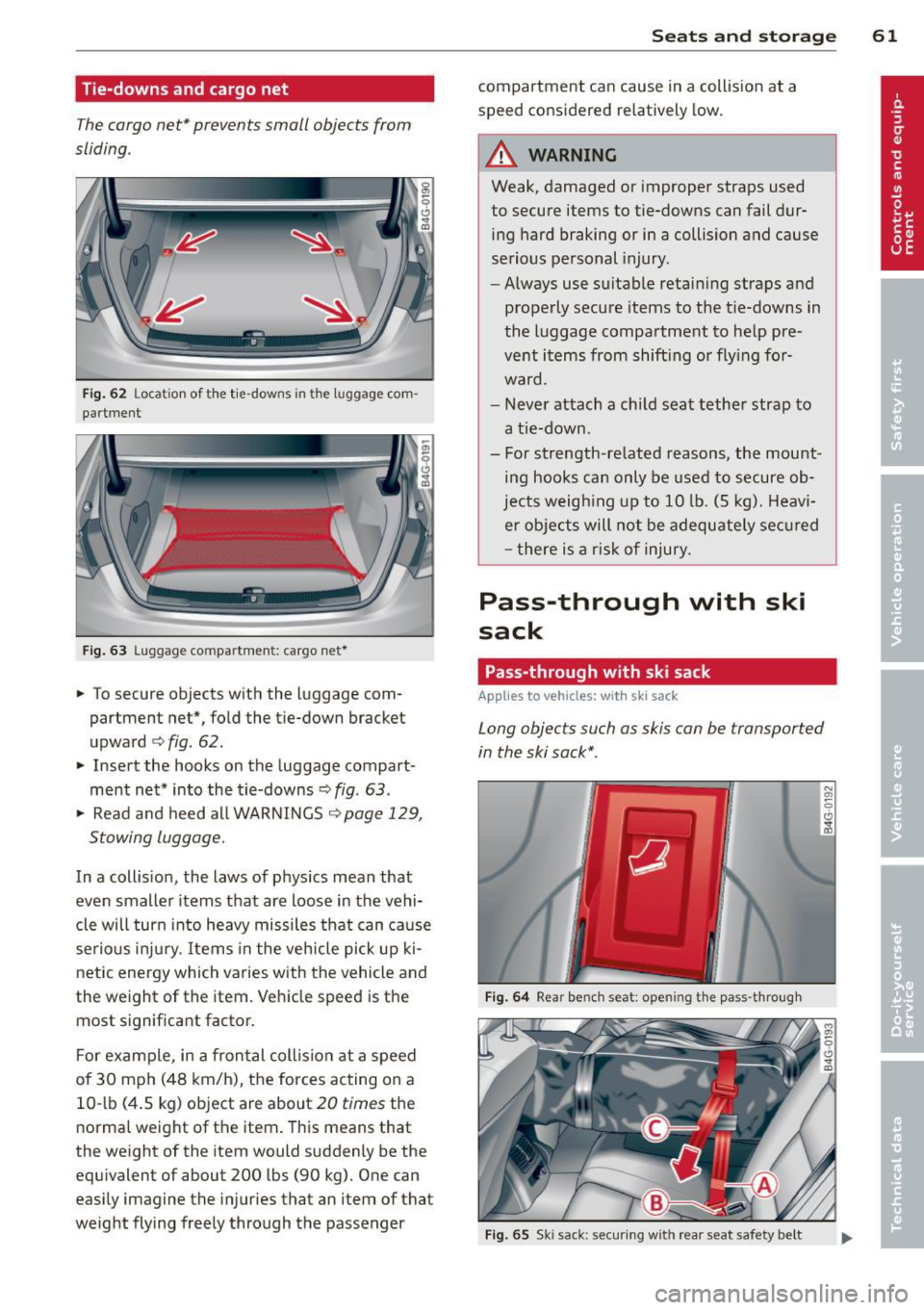
Tie-downs and cargo net
The cargo net* prevents small objects from
sliding .
Fig. 62 Location of th e tie -downs in the luggage com
partment
Fig. 63 Lugg age compartment: cargo net•
.. To secure objects with the luggage com·
partment net*, fold the tie-down bracket
upward
q fig. 62.
.. Insert the hooks on the luggage compart
ment net* into the tie-downs
q fig . 63 .
.. Read and heed all WARNINGS 9page 129,
Stowing luggage.
In a collision, the laws of phys ics mean that
even smaller items that are loose in the vehi
cle will turn into heavy missiles that can cause
serio us i njury. Items in the vehicle pick up ki
netic energy which varies with the vehicle and
the weight of the item. Vehicle speed is the
most significant factor.
F or example, in a frontal coll is ion at a speed
of 30 mph (48 km/h), the forces acting on a
10- lb (4.5 kg) object are about
20 times the
no rma l weight of the item. This means that
the weight of the item would suddenly be the
equivalent of about 200 lbs (90 kg). One can
easily imagine the injuries that an item of that
weight flying freely through the passenger
Seats and storage 61
compartment can cause in a collision at a
speed considered relatively low.
A WARNING
Weak, damaged or improper straps used
to secure items to tie-downs can fail dur
ing h ard braking or in a collision and cause
serious personal injury.
- Always use suitable retaining straps and
properly secure items to the tie-downs in
the luggage compartment to help pre
vent items from shifting or flying for
ward.
- Never attach a child seat tether strap to
a t ie-down .
- For strength-related reasons, the mount
ing hooks can only be used to secure ob
jects weigh ing up to 10 lb. (5 kg). Heavi
er objects will not be adequately secured
- there is a risk of injury.
Pass-through with ski
sack
Pass-through with ski sack
App lies to vehicles : wi th ski sa ck
Long objects such as skis can be transported
in the ski sack* .
Fig. 64 Rear bench seat: opening the pass -through
Fig. 65 Sk i sack: secu ring with rea r seat safety belt
Page 64 of 298
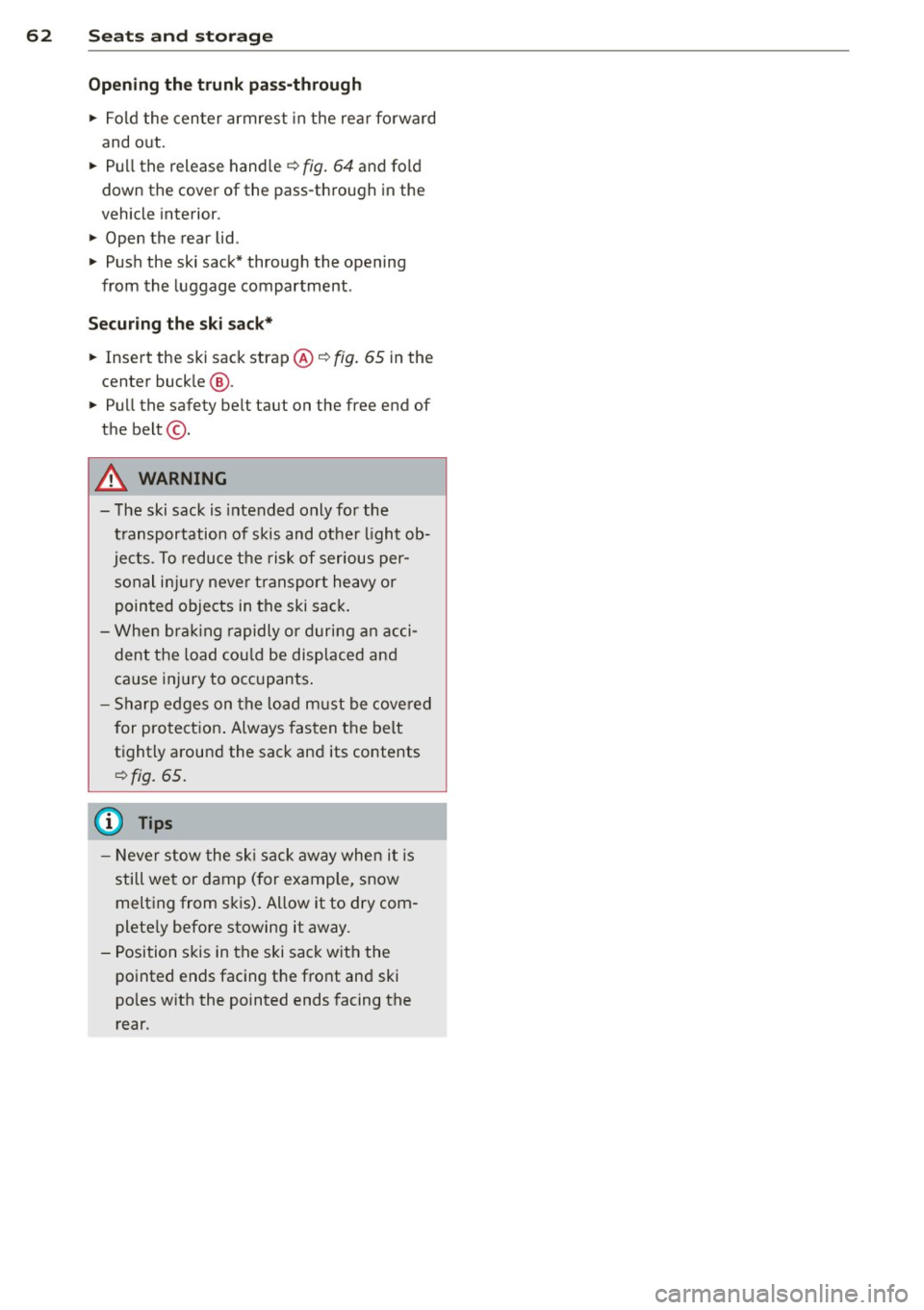
62 Seat s a nd s tor ag e
Op ening th e trunk p ass-through
.. Fold the center armrest in the rea r forward
and out .
.. Pull the release handle ¢
fig. 64 and fold
down the cover of the pass -through in the
vehicle interior .
.. Open the rear lid .
.. Push the ski sack* through the opening
from the luggage compartment .
Sec uring the sk i s a ck *
.. Insert the ski sack strap@¢ fig. 65 in the
center buck le @ .
.. Pull the safety belt taut on the free end of
the belt @.
A WARNING
-The ski sack is intended only for the
t ransportation of skis and other light ob
jects . To reduce the risk of serious per
sonal inj ury never t ransport heavy o r
pointed objects in the ski sack .
- When brak ing rapidly o r during an acci
dent the load cou ld be displaced and
cause injury to occupants .
- Sharp edges on the load must be covered
for protection . Always fasten the belt
tightly around the sack and its contents
¢ fig. 65.
(D Tips
- Never stow the sk i sack away when it is
still wet or damp (for example, snow
melting from skis). Allow it to dry com
plete ly before stowing it away.
- Position skis in the ski sack with the pointed ends facing the front and ski
po les with the pointed ends facing the
rear.
Page 65 of 298
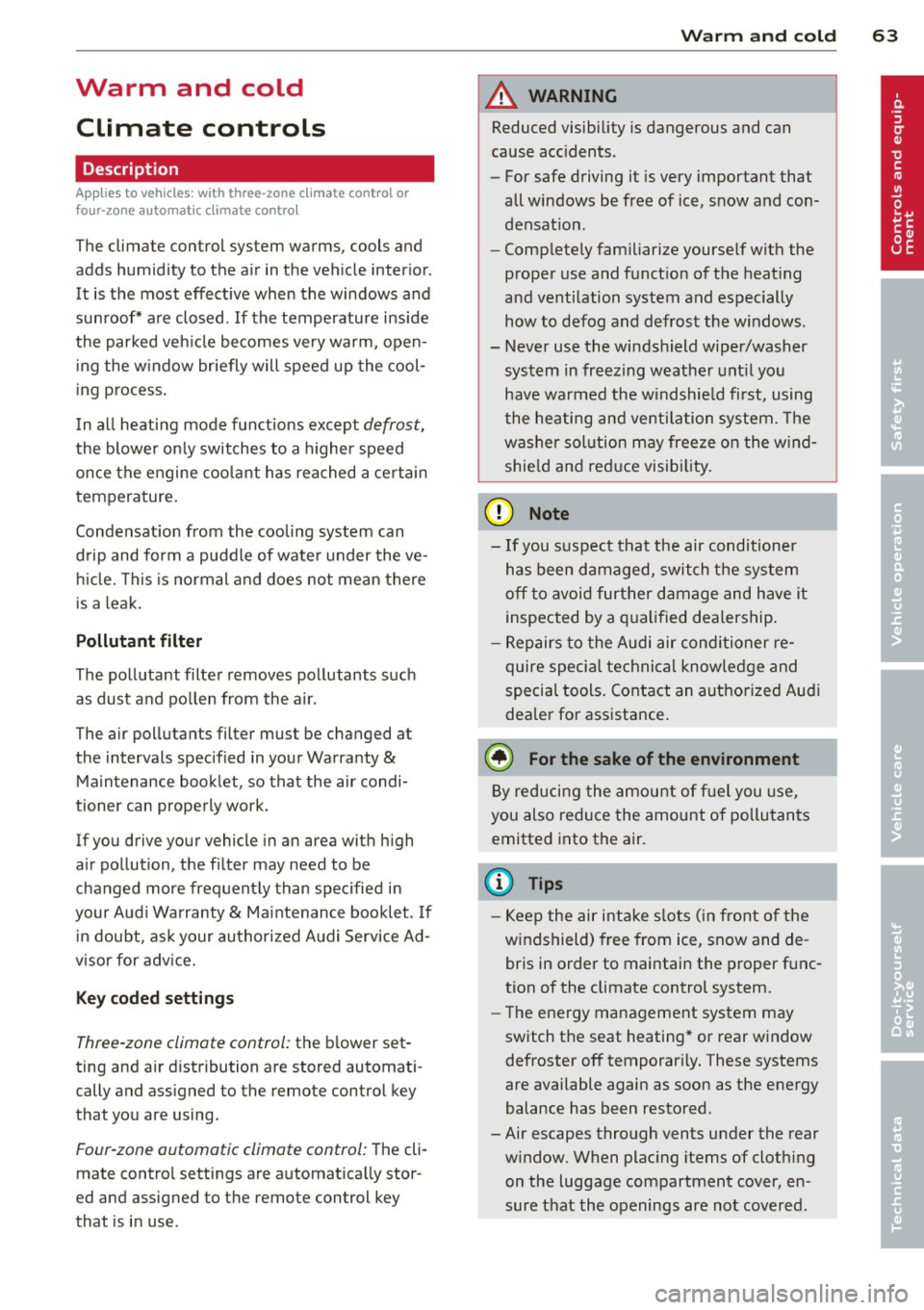
Warm and cold Climate controls
Description
App lies to vehicles: with three -zone cl imate contro l or
four -zone a uto mat ic climate contro l
The climate control system warms, cools and
adds humidity to the air in the vehicle interior .
It is the most effective when the windows and
sunroof* are closed . If the temperature inside
the parked veh icle becomes very warm, open
i ng the w indow br iefly will speed up the cool
ing process.
In all heating mode functions except
defrost,
the blower on ly switches to a higher speed
once the engine coolant has reached a certain
temperature.
Condensat ion from the cooling system can
drip and form a puddle of wate r under the ve
h icle. This is normal and does not mean there
is a leak .
Pollutant filt er
The pollutant filter removes pollutants such
as dust and po llen from the air.
The air pollutants filter must be changed at
the intervals specified in your Warranty
&
Maintenance booklet, so that the air condi
tioner can properly work .
If you drive your vehicle in an area with high
a ir pollution, the filter may need to be
changed more frequently than specified in
your Aud i Warranty
& Ma intenance booklet. If
i n doubt, ask your authori zed Audi Service Ad
visor for adv ice.
K ey coded settings
Three-zone climate control: the blower set
ting and air distribution are stored automati
cally and ass igned to the remote control key
that you are using.
Four-zone automatic climate control: The cli
mate contro l settings are automatica lly stor
ed and assigned to the remote control key
that is in use .
Warm and c old 63
A WARNING
-
Reduced visibi lity is dangerous and can
cause acc idents .
- For safe driving it is very important that
all windows be free of ice, snow and con
densat ion.
- Comp letely fam il iarize yourse lf with the
proper use and funct ion of the heat ing
a nd ventilation system and especially
how to defog and defrost the w indows.
- Never use the windshield wiper/washer system in freez ing weathe r unt il you
have wa rmed the windshie ld first, using
the heating and ventilation system. The
washer sol ution may freeze on the wind
shie ld and red uce visibi lity.
CJ) Note
- If you s uspect that the air conditioner
has been damaged, switch the system
off to avoid furt her damage and have it
inspected by a qualified dea lership .
- Repairs to the Audi air conditioner re
quire specia l technical know ledge and
special tools. Contact an authorized Audi
dealer fo r ass istance.
@ For the sake of the envi ronment
By reducing the amount of f uel you use,
you also red uce the amount of pollutants
emitted into the air.
(D Tips
- Keep the air intake s lo ts ( in front of the
w indshield) free from ice, snow and de
bris in order to maintain the proper func
tion of the climate control system.
- The energy ma nagement system may
switch the seat heating* or rear window defroster off temporar ily. These systems
are available again as soon as the energy
balance has been restored .
- Air escapes through vents under the rear
window. When plac ing items of cloth ing
on the luggage compartment cover, en
sure that the openings are not covered.
Page 66 of 298
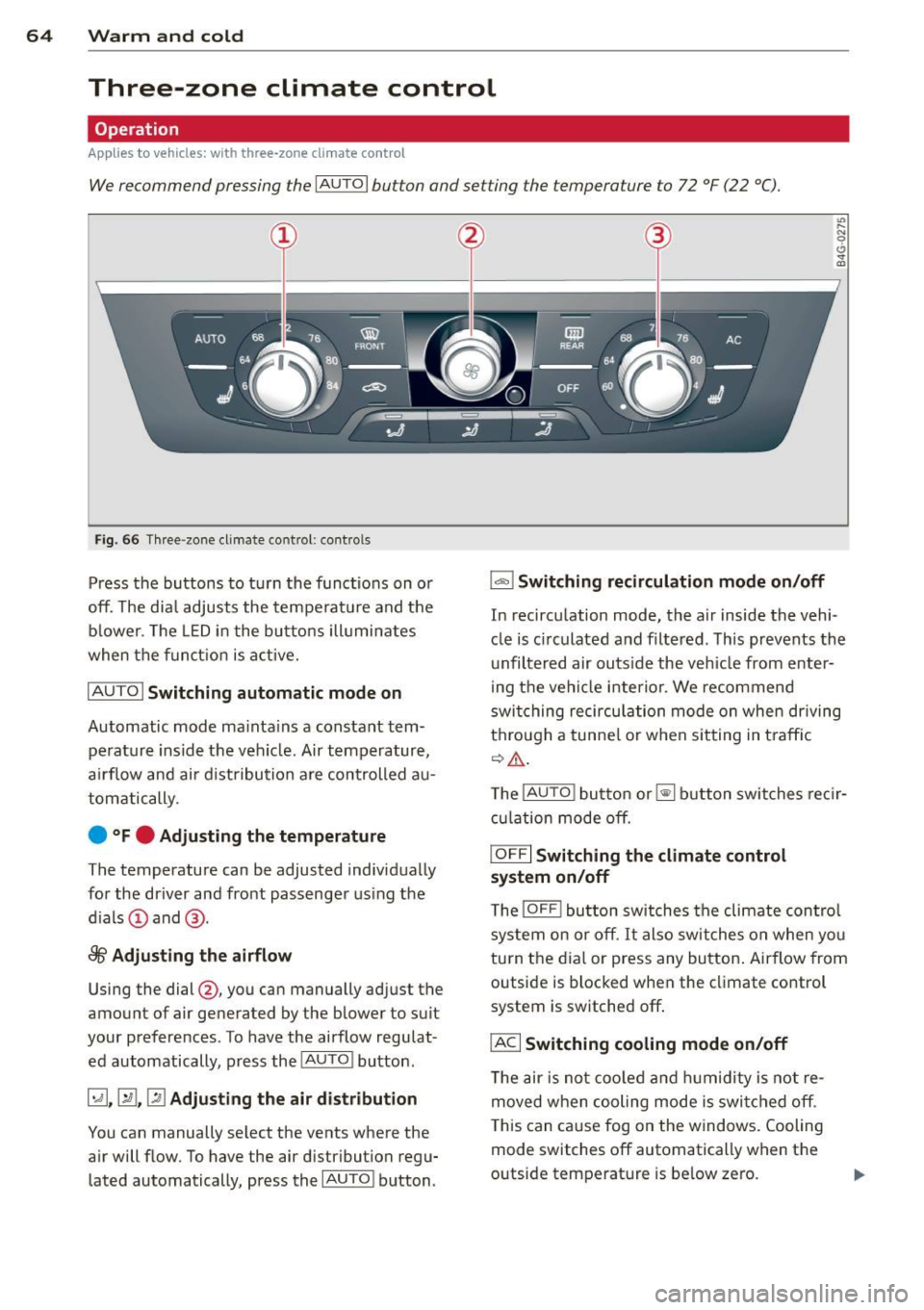
64 Warm and cold
Three-zone climate control
Operation
Applies to vehicles: with three -zone climate control
We recommend pressing the IAUTO I button and setting the temperature to 72 °F (22 °C).
F ig. 66 Three-zone cl imate co ntrol: cont ro ls
Press the buttons to turn the funct ions on or
off. The dia l adjusts the temperature and the
blower. The LED in the butto ns ill uminates
when the function is active.
IAUTO I Switching automatic mode on
Automatic mode mainta ins a constant tem
perature inside the vehicle . Air temperature,
airflow and air distribution are controlled au
tomatically.
e °Fe Adjusting the temperature
The temperature can be adjusted individua lly
for the driver and front passenger using the
dials @and @.
8fr Adjusting the airflow
Using the dial@, you can manually adjust the
amount of air generated by the blower to suit
your preferences . To have the airflow regulat
ed automatically, press the
!AU TO ! button .
~.~ .~ Adjusting the air distribution
You can manually se lect the vents where the
air will flow. To have the air distribution regu
lated automatically, press the
IAUTOI button.
1..,., 1 Switching recirculation mode on/off
"' ..... g
0 .. a,
In recirculation mode, the air inside the vehi
cle is c irculated and filtered . This prevents the
unfiltered air outside the veh icle from enter
ing the vehicle interior . We recommend
switching recirculation mode on when driving
through a tunnel or when sitting in traffic
¢ ,&.
The !AUTO ! button or~ button swit ches recir
culation mode off.
IOFFI Switching the climate control
system on/off
T he IOFF ! button switches the climate cont rol
system on or off.
It also switches on when you
turn the dial or press any button . Airflow from
outside is blocked when the climate control
system is switched off .
IACI Switching cooling mode on/off
The air is not cooled and humidity is not re
moved when cooling mode is switched off .
T his can cause fog on the windows. Cooling
mode switches off automatically when the
outside temperature is be low zero.
Page 67 of 298
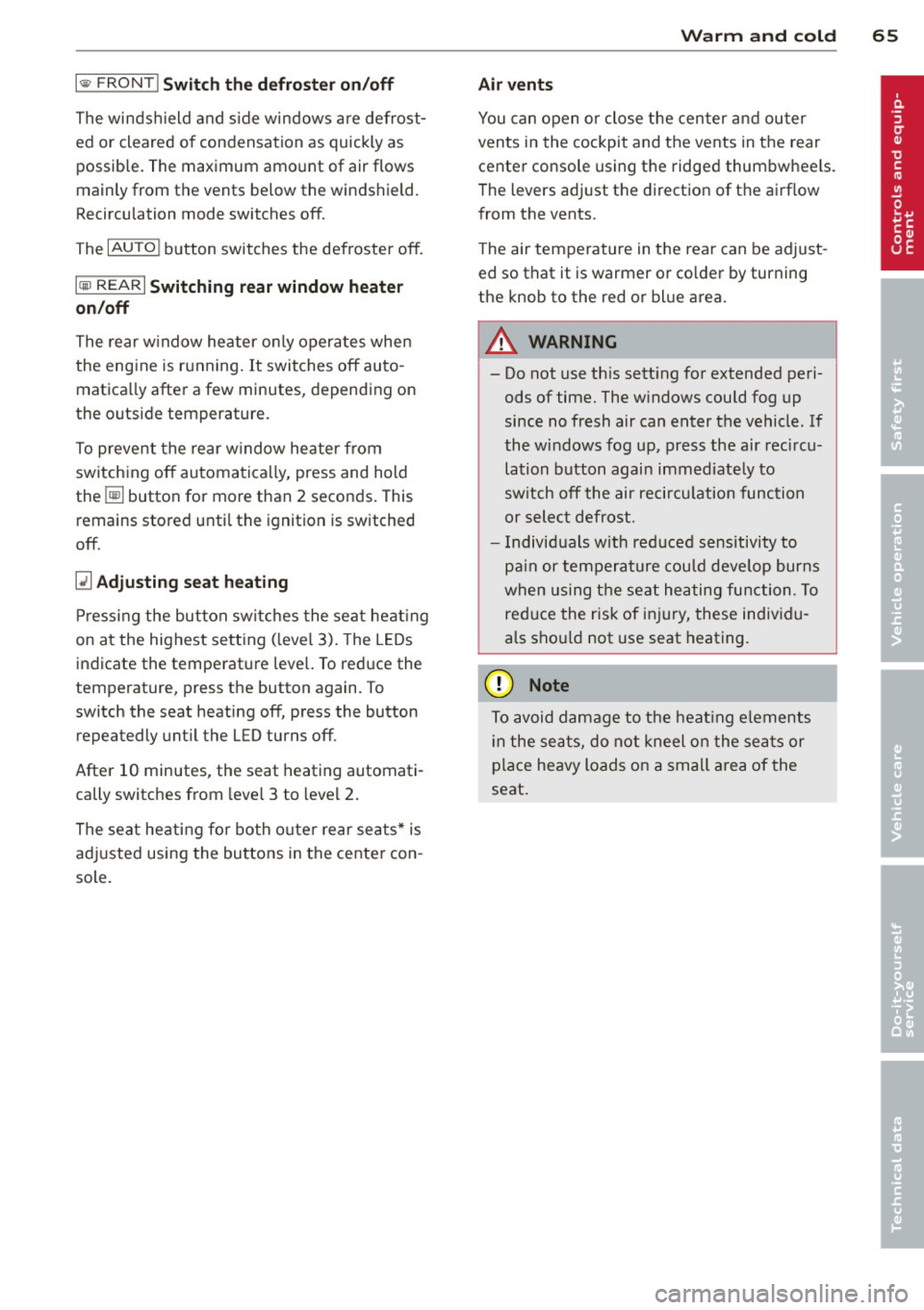
l
ed or cleared of condensation as quickly as possib le. The maximum amount of air flows
mainly from th e vents be low the windshield.
Recirculation mode switches off .
The
IAU TO I button switches the defroster off.
ICi@ REAR I Switching rear window heate r
on /off
The rear w indow heater only operates when
the engine is running. It switches off auto
matica lly after a few minutes, depending on
the outside temperature.
To prevent the rear w indow heater from
switching off automatically, press and hold
the ~ button for more than 2 seconds. This
remains stored unti l the ignition is switched
off.
[il A dj ustin g seat heat ing
Pressing the button swi tches the seat heating
on at the highest sett ing ( leve l 3) . The LEDs
indicate the temperature leve l. To reduce the
temp erature, press the button again. To
switch the seat heating off, press the button
repeatedly unt il the LED turns off .
After 10 minutes , the seat heating automati
cally switches from leve l 3 to level 2.
The seat heating for both outer rear sea ts* is
ad justed using the buttons in the cente r con
sole.
Warm and c old 65
Air vents
You can open or close the center and outer
vents in the cockpit and the vents in the rear
center console using the ridged thumbwheels.
The l evers adjust the dir ection of the airflow
from the vents.
T he air temperature in the rear can be adjust
ed so that it is warmer or co lder by turning
the knob to the r ed or blue area.
A WARNING
- Do not use this setting for extended peri
ods of time. The w indows could fog up
since no fresh air can enter the vehicle . If
the windows fog up, press the air rec ircu
lation button again immediate ly to
sw itch off the air reci rcu lation function
or select defrost .
- I ndividuals w ith reduced sensitivity to
pa in or tempera ture cou ld deve lop burns
when using the seat heating function . To
red uce the risk of i nju ry, these indiv idu
a ls sho uld not use seat heating.
(D Note
To avoid damage to the heat ing e lements
i n the sea ts, do not kneel on the seats or
place heavy loads on a small area of the
seat.
Page 68 of 298
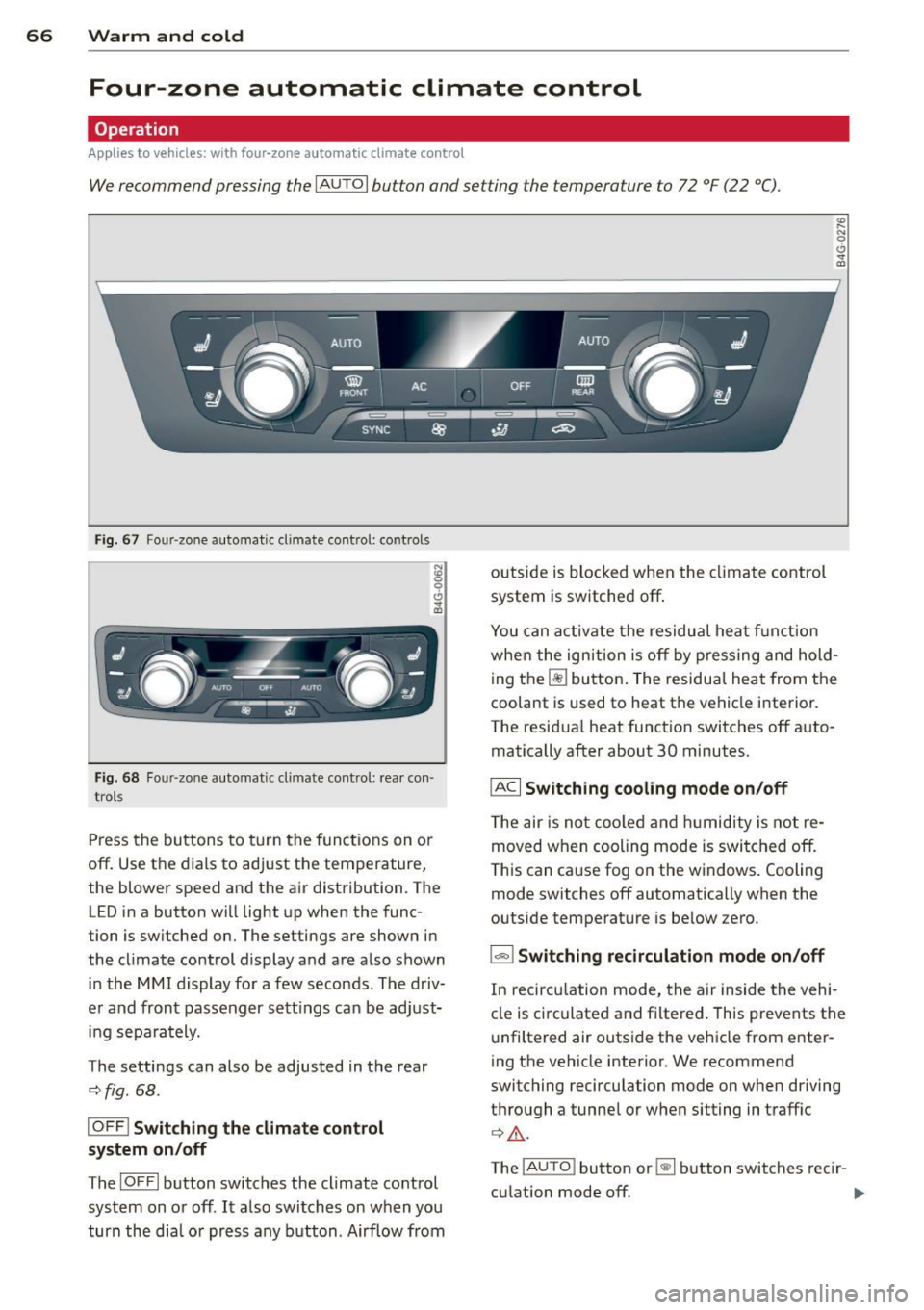
66 Warm and cold
Four-zone automatic climate control
Operation
Applies to vehicles: with four -zone automatic climate control
We recommend pressing the IAUTO I button and setting the temperature to 72 °F (22 °C).
Fig. 67 Four-zone automat ic climate contro l: controls
Fig . 68 Fou r-zone automatic cl imate cont rol: rear con ·
trol s
Press the buttons to turn the functions on or
off. Use the dials to adjust the temperature,
the blower speed and the air distribution. The
LED in a button will light up when the func
tion is switched on. The settings are shown in
the climate control display and are also shown in the MMI display for a few seconds . The driv
er and front passenger sett ings can be adjust
ing separately.
The settings can also be adjusted in the rear
<::;> fig. 68.
IOFF j Switching the climate control
system on/off
The I O FFI button switches the climate control
system on or off .
It also switches on when you
turn the dia l or press any button . Airflow from outside is blocked when the
climate control
system is switched off .
You can activate the residual heat f unction
whe n the ignition is off by pressing and hold
ing the ~ button. The residua l heat from the
coolant is used to heat the vehicle interior .
The residual heat function switches off auto
matically after about 30 minutes.
!ACI Switching cooling mode on/off
The air is not cooled and humidity is not re
moved when cooling mode is switched off.
This can cause fog on the windows. Cooling
mode switches off automatically when the
outside temperature is below zero .
1-1 Switching recirculation mode on/off
In recirculation mode, the air inside the vehi
cle is circ ulated and filtered. This prevents the
unfiltered air outside the vehicle from enter
ing the vehicle interior . We recommend
switching recirculation mode on when driving
through a tunnel or when sitting in traffic ¢ .&, .
The
! AUTO I button or~ button switches rec i r-
cu lation mode off. .,.
Page 69 of 298
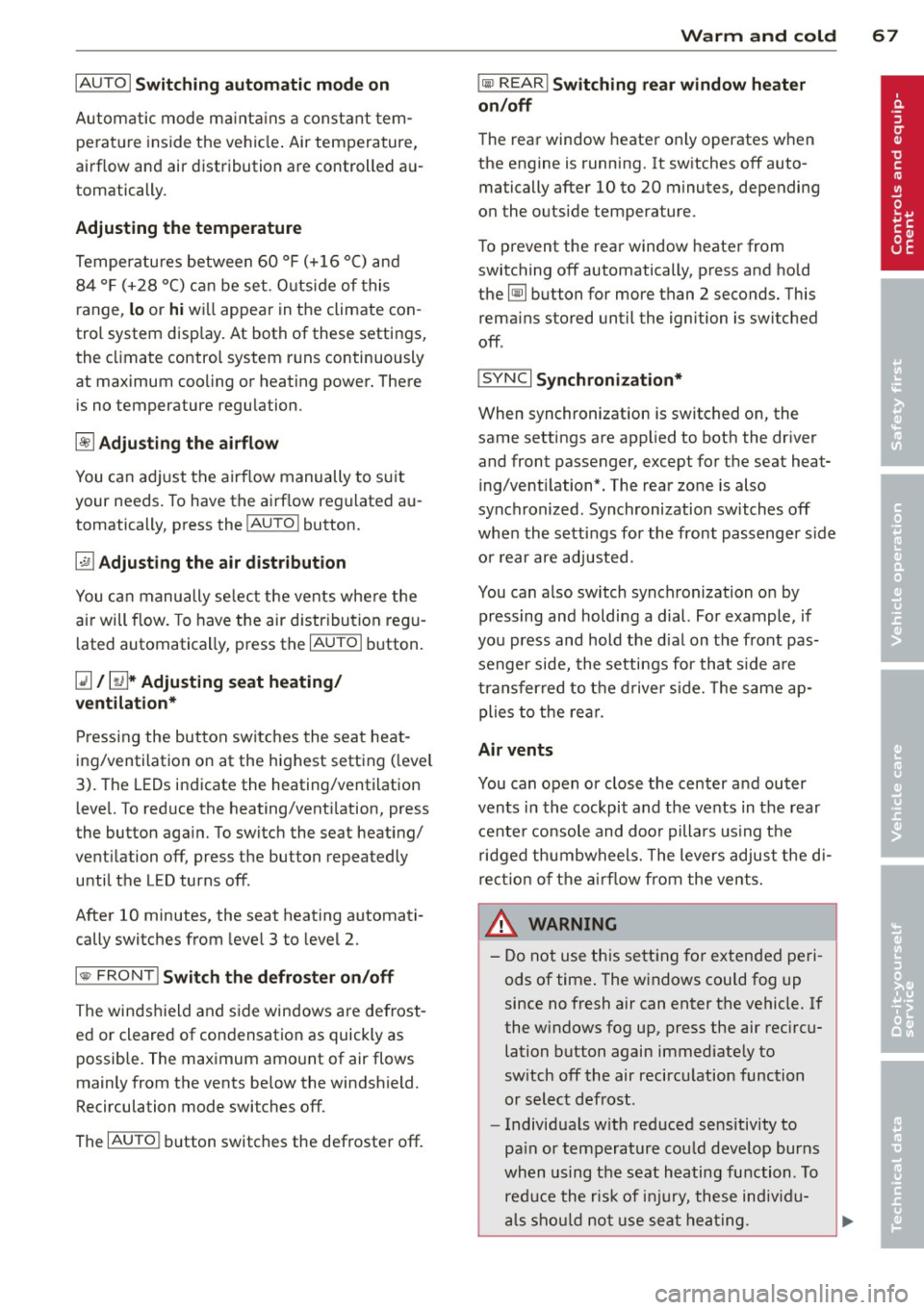
IAUTO I Switching automatic mode on
Automatic mode mainta ins a constant tem
perature inside the vehicle . Air temperature,
airflow and air distribution are controlled au
tomatically.
Adjusting the temperature
Temperatu res between 60 °F (+16 °C) and
84 °F ( +28 °C) can be set. O uts ide of this
range,
lo or hi wi ll appear in the climate con
trol system disp lay. At both of these settings,
the climate control system runs continuously
at maximum cooling or heating power. There
is no temperature regulation.
~ Adjusting the airflow
You can adjust the airf low manually to suit
your needs . To have the airf low regulated au
tomatically, press the
I AU TOj button.
li!J Adjusting the air distribution
You can manually se lect the vents where the
air will flow. To have the air distribution regu
lated automatically, press the
IAUTOI button .
~I~ * Adjusting seat heating/
ventilation*
Pressing the button switches the seat heat
ing/ventilation on at the highest setting ( level
3). The LEDs indicate the heating/ventilation
level. To reduce the heating/venti lation, press
the button again. To switch the seat heating/
ventilation off, press the button repeatedly
until the LED turns off.
After 10 minutes, the seat heating automati
cally switches from level 3 to level 2.
I@ FRONT I Switch the defroster on/off
The windshield and side windows are defrost
ed or cleared of condensation as quickly as
possible. The maximum amount of air flows
mainly from the vents below the windshield.
Recircula tion mode switches off.
The
IAU TOI button switches the defroster off.
Warm and cold 67
liiii REAR! Switching rear window heater
on/off
The rear window heater only operates when
the engine is running. It switches off auto matically after 10 to 20 minutes, depending
on the outside temperature.
To prevent the rear window heater from
switching off automatically, press and ho ld
the~ button for more than 2 seconds. This
remains stored until the ignition is switched
off .
I SYNC I Synchronization*
When synchronization is switched on, the
same settings are applied to both the driver
and front passenger, except for the seat heat
ing/ventilation*. The rear zone is also
synchronized. Synchronization switches off
when the settings for the front passenger s ide
o r r ear are adjusted.
You can also switch synchronization on by pressing and holding a dial. For example, if
you press and hold the dial on the front pas
senger side, the settings for that side are
transferred to the driver side. The same ap
plies to the rear.
Air vents
You can open or close the center and outer
vents in the cockpit and the vents in the rear
cente r console and door pillars using the
ridged thumbwheels. The levers adjust the di
rection of the airflow from the vents.
&_ WARNING
-=
-Do not use this setting for extended peri-
ods of time . The windows could fog up
since no fresh air can enter the vehicle. If
the windows fog up, press the air recircu
lation button again immediately to
sw itch off the air recircu lation function
or select defrost.
- Individuals w ith reduced sensitivity to
pa in or temperature cou ld deve lop burns
when using the seat heating function . To
red uce the risk of injur y, these individu-
als should not use seat heating . ..,.
Page 70 of 298
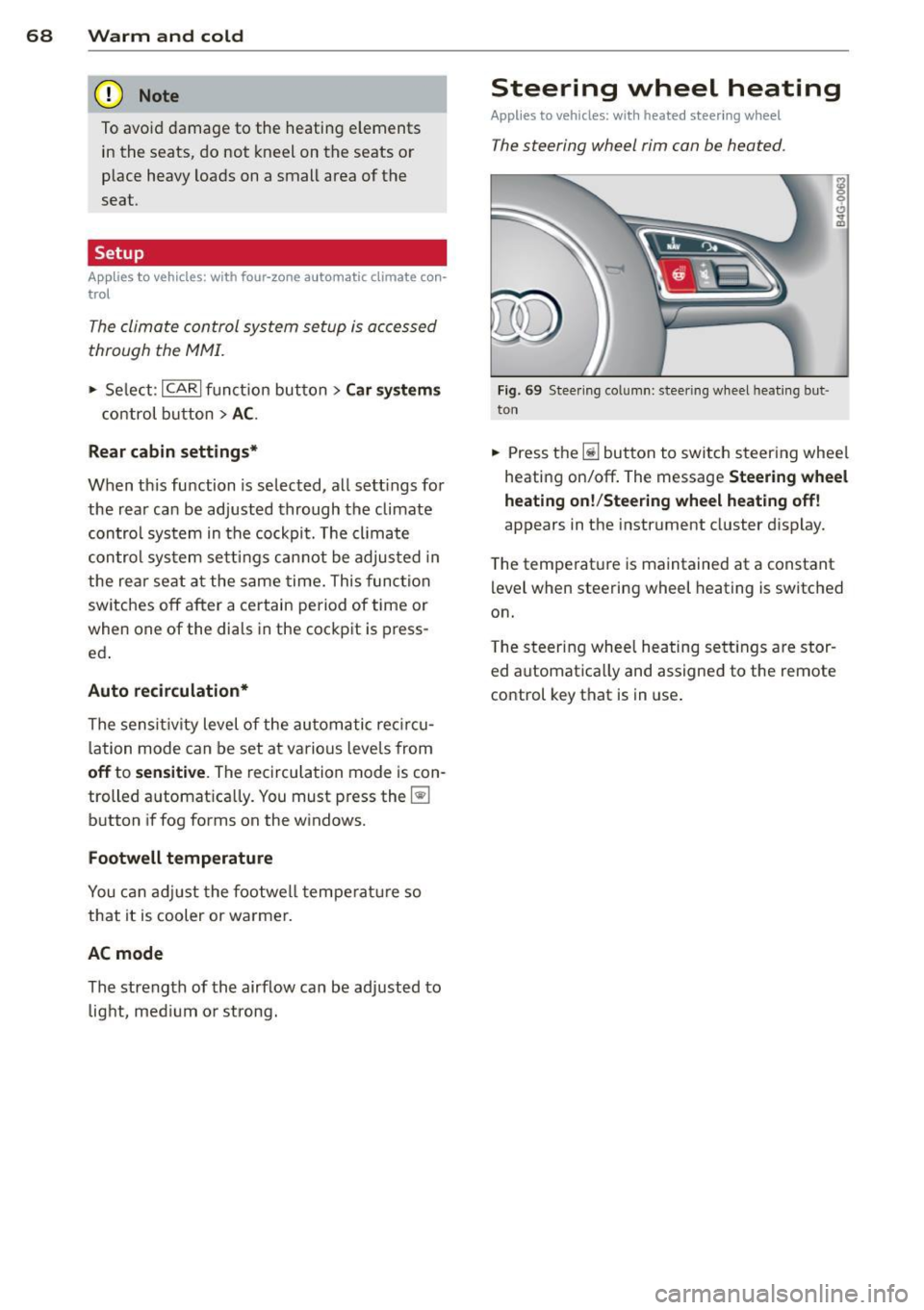
68 Warm and cold
(D Note
To avoid damage to the heating e lements
in the seats, do not kneel on the seats or
place heavy loads on a small area of the
seat .
Setup
Applies to vehicles: with four-zone a utomat ic climate con·
trol
The climate control system setup is accessed
through the MMI .
.,. Se lect : ICARI funct ion button> Car sy stem s
control b utton > AC .
Rear cabin settings*
When th is fu nction is selected, all sett ings for
the rear can be adjusted through the climate
control sys tem in the cockpit. The cl imate
con trol sys tem se tt ings cannot be adjusted in
the rea r seat a t the same time. This func tion
switches
off after a certain period of time or
when one of the dials in the cockpit is press
ed .
Auto recirculation*
The sensit ivity level of the au tomatic rec ircu
lation mode can be set at vario us leve ls from
off to sensit ive. The recirculation mode is con
trolled a utomat ica lly. You must p ress the ~
button if fog forms on the windows.
Footwell temperature
You can adju st the footwell temperat ure so
that it is cooler or wa rme r.
AC mode
The strength of the airflow can be adjusted to
light, med ium or strong.
Steering wheel heating
Applies to vehicles: wit h heated stee rin g wheel
The steering wheel rim can be heated .
Fig. 6 9 Stee ring colu mn: steeri ng wheel hea tin g but ·
ton
.,. Press th e ~ button to switch steering whee l
heati ng on/off . The message
Steering wheel
heating on !/Steering wheel heating off !
appears in the instrument cluster d isplay.
T he temperat ure is maintained at a constant
level when steering wheel heating is switched
on.
T he steering wheel heating se tt ings are stor
ed automat ica lly and assigned to the remote
control key that is in use .